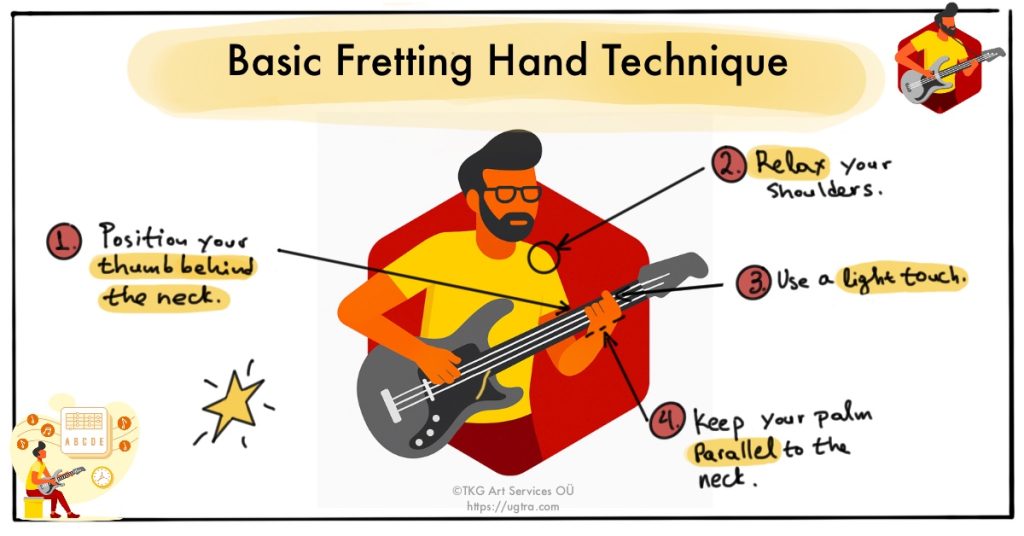[This piece comes from my Guitar Technique Booster Course. It’s focused on the basic fretting hand guitar technique and has been lightly adapted for this article.]
As I wrote in my article The Fundamental Picking-Hand Mechanics of Alternate Picking: Imagine walking into a gym, grabbing the heaviest weights, and lifting with poor posture. Does adding more weight really make you stronger? Quite the opposite—it amplifies flaws, increases injury risk, and stalls progress. The same principle applies to guitar playing. Without mastering the fundamental mechanics of your picking and fretting hands, adding more exercises or increasing speed only buries bad habits deeper.
Most self-taught guitarists fall into the trap of endlessly searching for the “best” exercises, hoping to unlock speed and precision. But here’s the truth: speed and smoothness are by-products of clean, repeatable motion. The secret isn’t in the exercises—it’s in fixing the mechanics first. Once your fretting-hand technique is correct, any exercise works. Until then, none will.
Today, we’ll explore the foundational mechanics of the fretting hand, focusing on proper technique, relaxation, and efficiency to help you build a solid foundation for speed, accuracy, and musical expression.
Proper Finger Placement: The Sweet Spot on the Fret
The first step to mastering fretting-hand technique is understanding where to place your fingers on the fretboard.- The sweet spot: Press just behind the fret, not directly on it. This minimizes fret buzz while requiring minimal pressure.
- Fingertip accuracy: Use the very tip of your finger, not the pad, to fret notes. The exception is when playing barre chords, where the pad or the side of your index finger is used to press multiple strings.
- Economy of motion: Keep your fingers close to the fretboard to reduce unnecessary movement and improve speed and accuracy.
Thumb Position: Your Undercover Anchor
Thumb placement plays a crucial role in providing stability and control for your fretting hand.
- Placement: Position your thumb behind the neck of the guitar, approximately opposite your middle finger. Avoid gripping the neck like a baseball bat.
- Flexibility: Allow your thumb to follow your fingers as they move vertically, horizontally, or diagonally across the fretboard. For techniques like vibrato and bends, the thumb can move above the neck for added leverage.
- Relaxation: Keep your thumb relaxed to avoid muscle tension, which can lead to hand fatigue or even injuries like carpal tunnel syndrome.
Curvature of the Fingers: The Arch for Clarity
The curvature of your fingers affects both clarity and muting technique.
- Lead playing: Contrary to classical guitar technique, keep your knuckles low when playing lead lines or scale patterns. This helps mute unwanted strings and ensures clean articulation.
- Chordal picking and rhythm guitar: For rhythm playing, raise your knuckles to allow multiple strings to ring out clearly. This is especially important for techniques like arpeggiating chords or strumming.
Wrist Position: The Keystone to Flexibility
Your wrist position is critical for both comfort and technique.
- Straight to slightly curved: Keep your wrist straight or slightly curved, but avoid bending it more than 90º. Excessive curvature increases tension and the risk of injury.
- Relaxation: A loose wrist allows for fluid movement and reduces muscle tension, enabling you to play for longer periods without fatigue.
Fretboard Position: Finding Your Home Base
Your guitar’s angle and your body posture significantly impact your fretting-hand technique. This is what I do:
- Guitar angle: I keep the guitar neck at an angle relative to your body. This makes it easier to reach higher frets without blocking my forearm against my torso.
- Guitar body position: I like to place the guitar body slightly away from my body, resting it on my right foot. Then I lean the instrument slightly toward me to maintain visual contact with the fretboard without leaning forward. This helps avoid back tension and pain.
Finger Pressure & Economy of Motion: Use the Lightest Touch for Speed and Precision
One of the most common mistakes guitarists make is pressing too hard on the strings.
- Light touch: Apply just enough pressure to produce a clean note. Excessive pressure not only tires your hand but also affects your speed and accuracy.
- Economy of motion: Avoid lifting your fingers too far away from the fretboard. Keep them close to minimize movement and improve efficiency.
- Common mistake: When playing single-string passages, avoid keeping your index finger pressed down when other fingers are fretting higher notes on the same string. This creates unnecessary tension.
Relaxation & Tension Management: Your Go-To Checklist
Tension is the enemy of speed and precision. Here’s a checklist to help you identify and eliminate tension:
- Do you lift your fingers too far away from the fretboard?
- Do you keep pressing the string with your index finger when playing higher notes on the same string?
- Is your wrist bent more than 90º?
- Are you lifting your left shoulder or tensing your upper arm?
- Do you feel any pain or discomfort?
If you answered “yes” to any of these, take a step back and reassess your technique. Relaxation is not just important for building muscle memory; it’s also essential for maintaining long-term hand health, preventing fatigue, and avoiding injuries that could hinder your progress.
FAQ: Your Fretting Hand Questions Answered
Should I touch the underside of the neck?
No. You need to maintain some space between your fretting hand’s palm and the bottom edge of the neck. This allows your fingers to move freely without tension.
Should I look at the fretboard while I play guitar?
Yes, especially when you’re starting out. Keep the guitar body angled slightly toward you so you can see the fretboard without leaning forward. As you improve your fretboard knowledge, you’ll rely less on visual cues and more on muscle memory.
My fingers hurt or get tired quickly. Is that normal?
This is often a sign of tension in your hand. Apply the techniques discussed above, and if pain persists, consult a medical expert to rule out conditions like carpal tunnel syndrome.
Should my fingers be parallel to the frets or angled?
I recommend keeping your fingers parallel to the frets. This reduces the distance your pinky finger needs to travel, helping to build accuracy and speed while minimizing tension.
Final Thoughts
Mastering proper fretting-hand technique is about more than just playing clean notes, it’s about building a foundation for speed, precision, and musical expression. If you focus on placing your fingers correctly, positioning your thumb well, aligning your wrist properly, and staying relaxed, you will improve your playing. You will also protect your hand from getting tired or injured.
Remember, the goal isn’t just to play faster, but to produce good quality notes. So, take the time to refine your technique, focusing on precision and control, and you’ll unlock a world of creative possibilities and musical expression on the guitar.
Now, pick up your guitar, apply these principles, and watch your fretting-hand skills transform. 🎸

